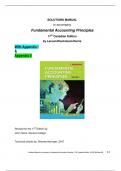Exam (elaborations)
Solution Manual for Fundamental Accounting Principles Volume 1 17th Canadian Edition By Kermit D. Larson, Heidi Dieckmann, John Harris
- Module
- Institution
Solution Manual for Fundamental Accounting Principles Volume 1 17th Canadian Edition By Kermit D. Larson, Heidi Dieckmann, John Harris
[Show more]



